Report: Monitoring and Limiting Corrosion in Marine Environments
VerifiedAdded on 2022/11/27
|33
|7396
|181
Report
AI Summary
This comprehensive report delves into the critical issue of corrosion in marine environments, meticulously examining its causes, effects, and potential mitigation strategies. The introduction defines corrosion as the deterioration of metallic materials through chemical reactions, detailing the oxidation and electrochemical processes involved. It explores the impact of environmental factors such as humidity, pollutants (including oxides of sulfur, nitrogen, and chlorine), and the inherent properties of metals like ionization energy and electron affinity. The report provides detailed chemical equations and explanations to illustrate these processes. It also examines the role of electrolytes and the resulting galvanic reactions in accelerating corrosion. The report aims to find the most cost-effective and simple methods or ways of monitoring corrosion in marine environments and to investigate the factors that affect corrosion of the steel structures in marine environment, how they affect and an effective ways(s) of reducing the rate of metal corrosion in metallic steel which is the main metal used in construction of marine structures and marine locomotives such as ships, yachts, ferries, boats and any other vessel used in marine transportation.
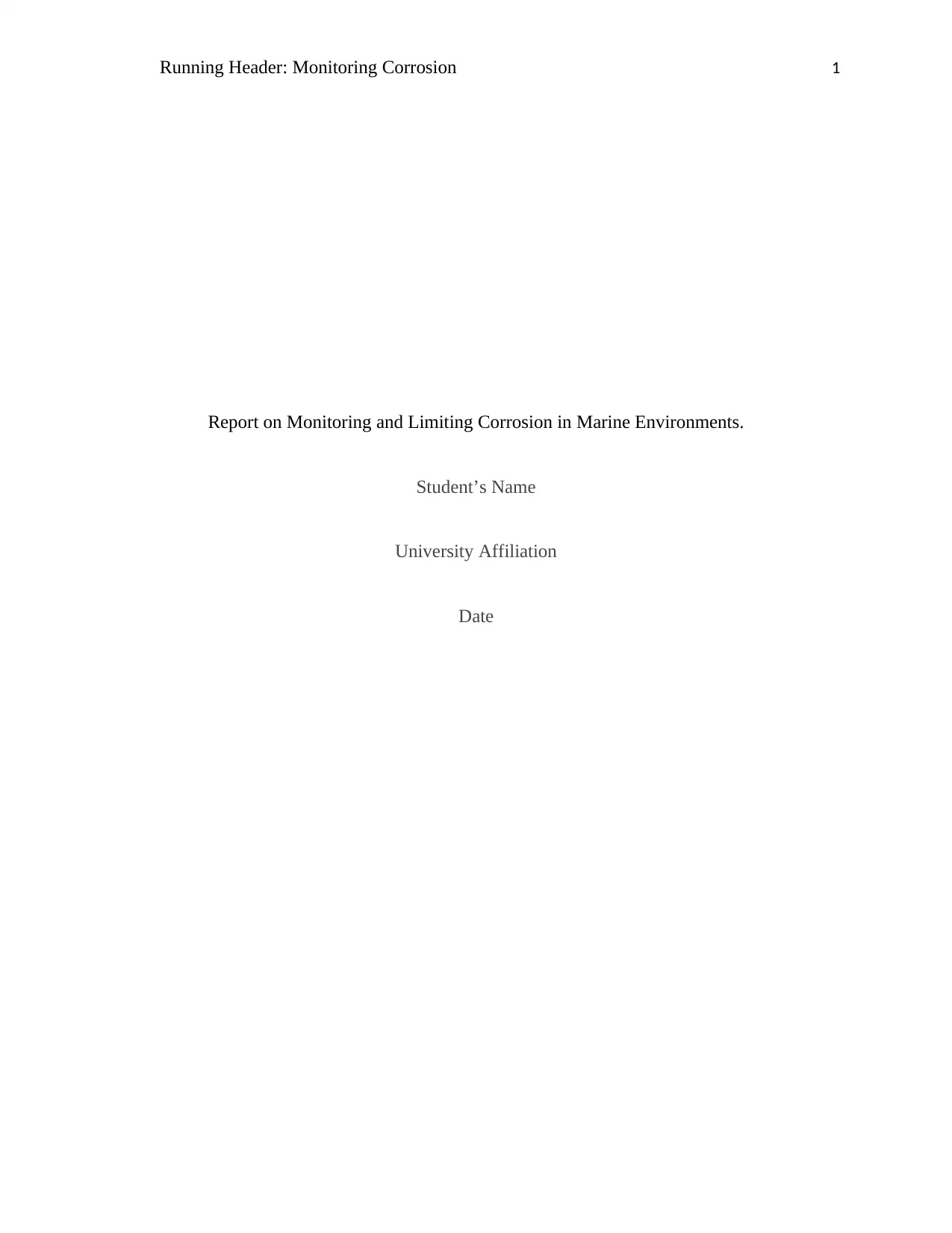
Running Header: Monitoring Corrosion 1
Report on Monitoring and Limiting Corrosion in Marine Environments.
Student’s Name
University Affiliation
Date
Report on Monitoring and Limiting Corrosion in Marine Environments.
Student’s Name
University Affiliation
Date
Paraphrase This Document
Need a fresh take? Get an instant paraphrase of this document with our AI Paraphraser
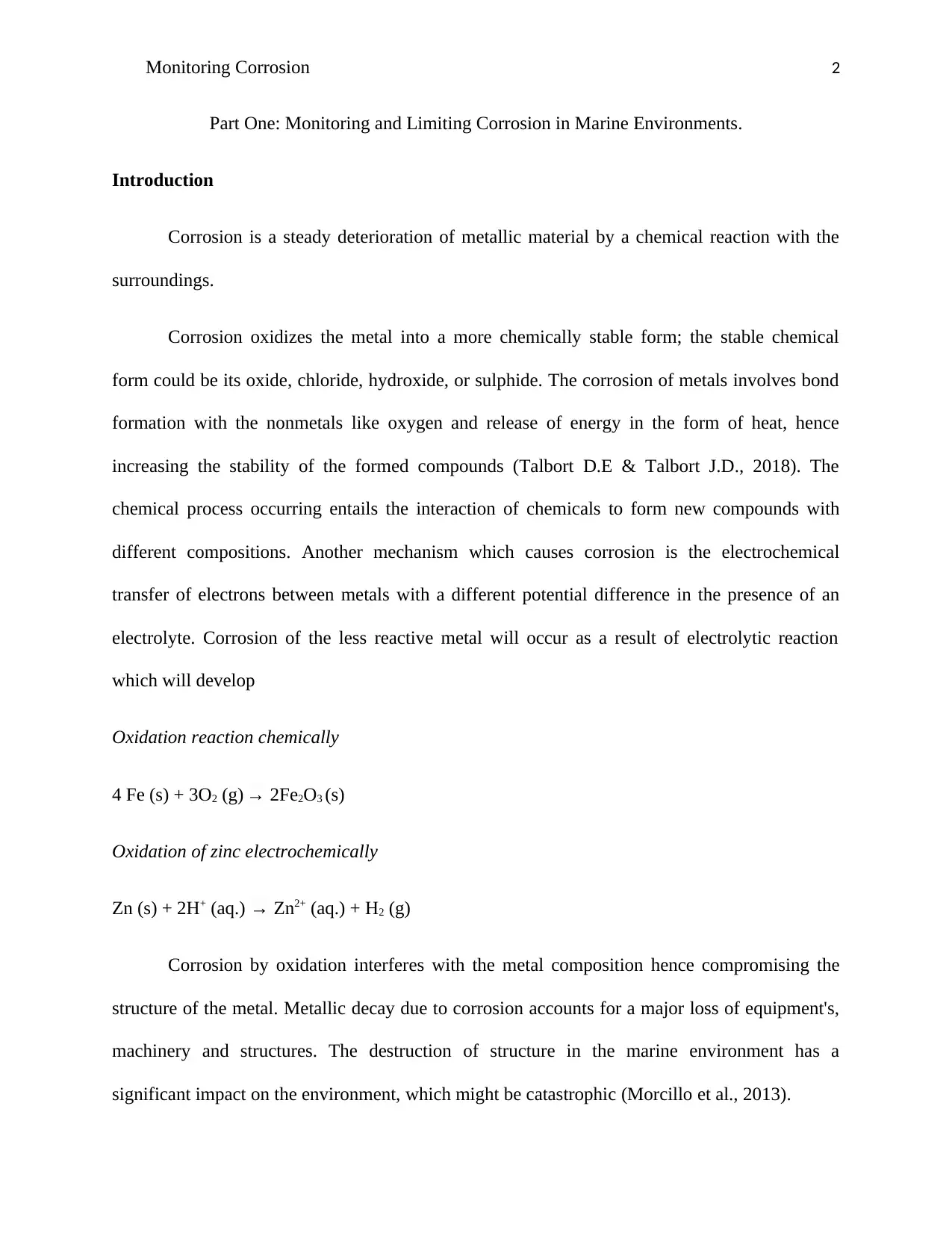
Monitoring Corrosion 2
Part One: Monitoring and Limiting Corrosion in Marine Environments.
Introduction
Corrosion is a steady deterioration of metallic material by a chemical reaction with the
surroundings.
Corrosion oxidizes the metal into a more chemically stable form; the stable chemical
form could be its oxide, chloride, hydroxide, or sulphide. The corrosion of metals involves bond
formation with the nonmetals like oxygen and release of energy in the form of heat, hence
increasing the stability of the formed compounds (Talbort D.E & Talbort J.D., 2018). The
chemical process occurring entails the interaction of chemicals to form new compounds with
different compositions. Another mechanism which causes corrosion is the electrochemical
transfer of electrons between metals with a different potential difference in the presence of an
electrolyte. Corrosion of the less reactive metal will occur as a result of electrolytic reaction
which will develop
Oxidation reaction chemically
4 Fe (s) + 3O2 (g) → 2Fe2O3 (s)
Oxidation of zinc electrochemically
Zn (s) + 2H+ (aq.) → Zn2+ (aq.) + H2 (g)
Corrosion by oxidation interferes with the metal composition hence compromising the
structure of the metal. Metallic decay due to corrosion accounts for a major loss of equipment's,
machinery and structures. The destruction of structure in the marine environment has a
significant impact on the environment, which might be catastrophic (Morcillo et al., 2013).
Part One: Monitoring and Limiting Corrosion in Marine Environments.
Introduction
Corrosion is a steady deterioration of metallic material by a chemical reaction with the
surroundings.
Corrosion oxidizes the metal into a more chemically stable form; the stable chemical
form could be its oxide, chloride, hydroxide, or sulphide. The corrosion of metals involves bond
formation with the nonmetals like oxygen and release of energy in the form of heat, hence
increasing the stability of the formed compounds (Talbort D.E & Talbort J.D., 2018). The
chemical process occurring entails the interaction of chemicals to form new compounds with
different compositions. Another mechanism which causes corrosion is the electrochemical
transfer of electrons between metals with a different potential difference in the presence of an
electrolyte. Corrosion of the less reactive metal will occur as a result of electrolytic reaction
which will develop
Oxidation reaction chemically
4 Fe (s) + 3O2 (g) → 2Fe2O3 (s)
Oxidation of zinc electrochemically
Zn (s) + 2H+ (aq.) → Zn2+ (aq.) + H2 (g)
Corrosion by oxidation interferes with the metal composition hence compromising the
structure of the metal. Metallic decay due to corrosion accounts for a major loss of equipment's,
machinery and structures. The destruction of structure in the marine environment has a
significant impact on the environment, which might be catastrophic (Morcillo et al., 2013).
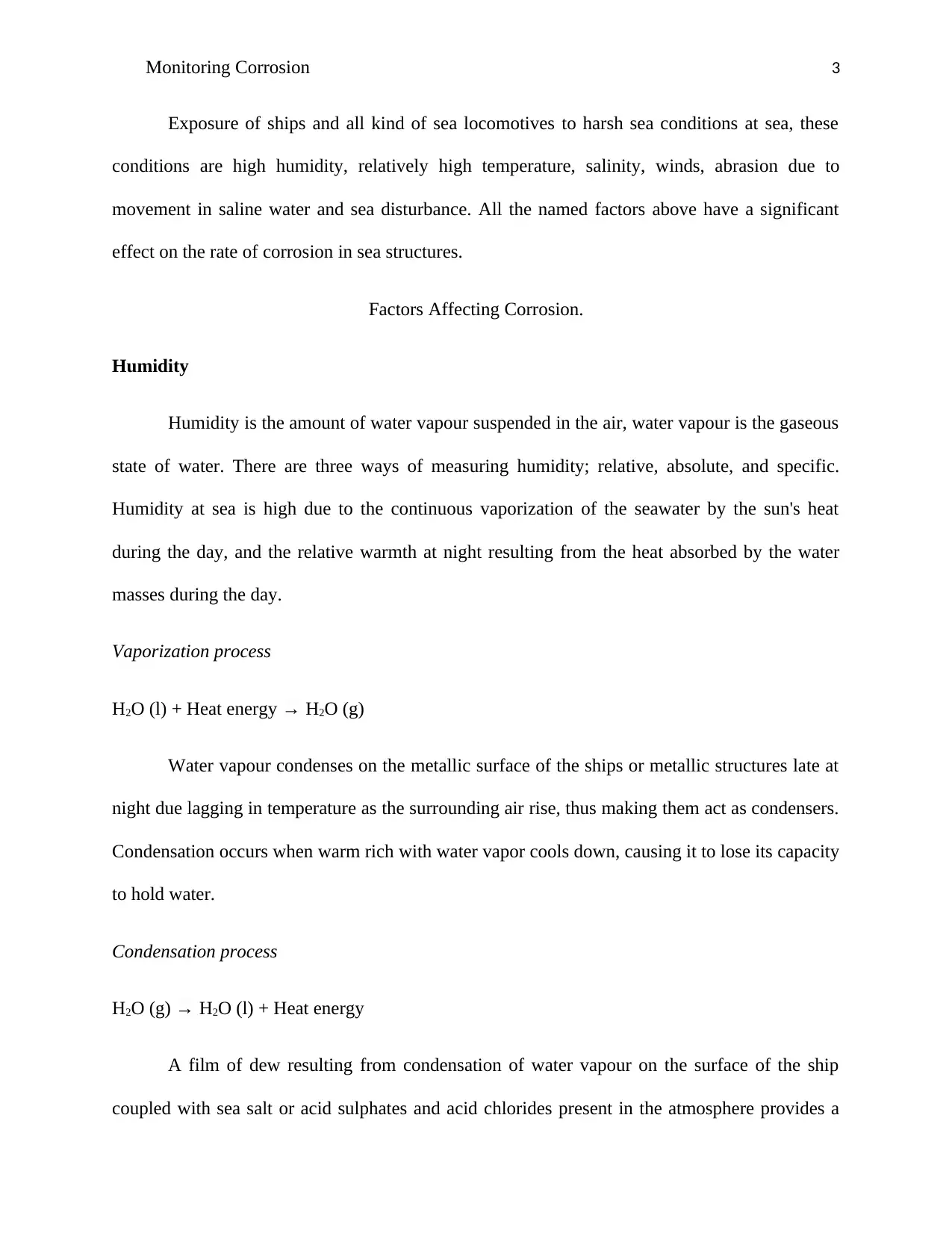
Monitoring Corrosion 3
Exposure of ships and all kind of sea locomotives to harsh sea conditions at sea, these
conditions are high humidity, relatively high temperature, salinity, winds, abrasion due to
movement in saline water and sea disturbance. All the named factors above have a significant
effect on the rate of corrosion in sea structures.
Factors Affecting Corrosion.
Humidity
Humidity is the amount of water vapour suspended in the air, water vapour is the gaseous
state of water. There are three ways of measuring humidity; relative, absolute, and specific.
Humidity at sea is high due to the continuous vaporization of the seawater by the sun's heat
during the day, and the relative warmth at night resulting from the heat absorbed by the water
masses during the day.
Vaporization process
H2O (l) + Heat energy → H2O (g)
Water vapour condenses on the metallic surface of the ships or metallic structures late at
night due lagging in temperature as the surrounding air rise, thus making them act as condensers.
Condensation occurs when warm rich with water vapor cools down, causing it to lose its capacity
to hold water.
Condensation process
H2O (g) → H2O (l) + Heat energy
A film of dew resulting from condensation of water vapour on the surface of the ship
coupled with sea salt or acid sulphates and acid chlorides present in the atmosphere provides a
Exposure of ships and all kind of sea locomotives to harsh sea conditions at sea, these
conditions are high humidity, relatively high temperature, salinity, winds, abrasion due to
movement in saline water and sea disturbance. All the named factors above have a significant
effect on the rate of corrosion in sea structures.
Factors Affecting Corrosion.
Humidity
Humidity is the amount of water vapour suspended in the air, water vapour is the gaseous
state of water. There are three ways of measuring humidity; relative, absolute, and specific.
Humidity at sea is high due to the continuous vaporization of the seawater by the sun's heat
during the day, and the relative warmth at night resulting from the heat absorbed by the water
masses during the day.
Vaporization process
H2O (l) + Heat energy → H2O (g)
Water vapour condenses on the metallic surface of the ships or metallic structures late at
night due lagging in temperature as the surrounding air rise, thus making them act as condensers.
Condensation occurs when warm rich with water vapor cools down, causing it to lose its capacity
to hold water.
Condensation process
H2O (g) → H2O (l) + Heat energy
A film of dew resulting from condensation of water vapour on the surface of the ship
coupled with sea salt or acid sulphates and acid chlorides present in the atmosphere provides a
⊘ This is a preview!⊘
Do you want full access?
Subscribe today to unlock all pages.

Trusted by 1+ million students worldwide
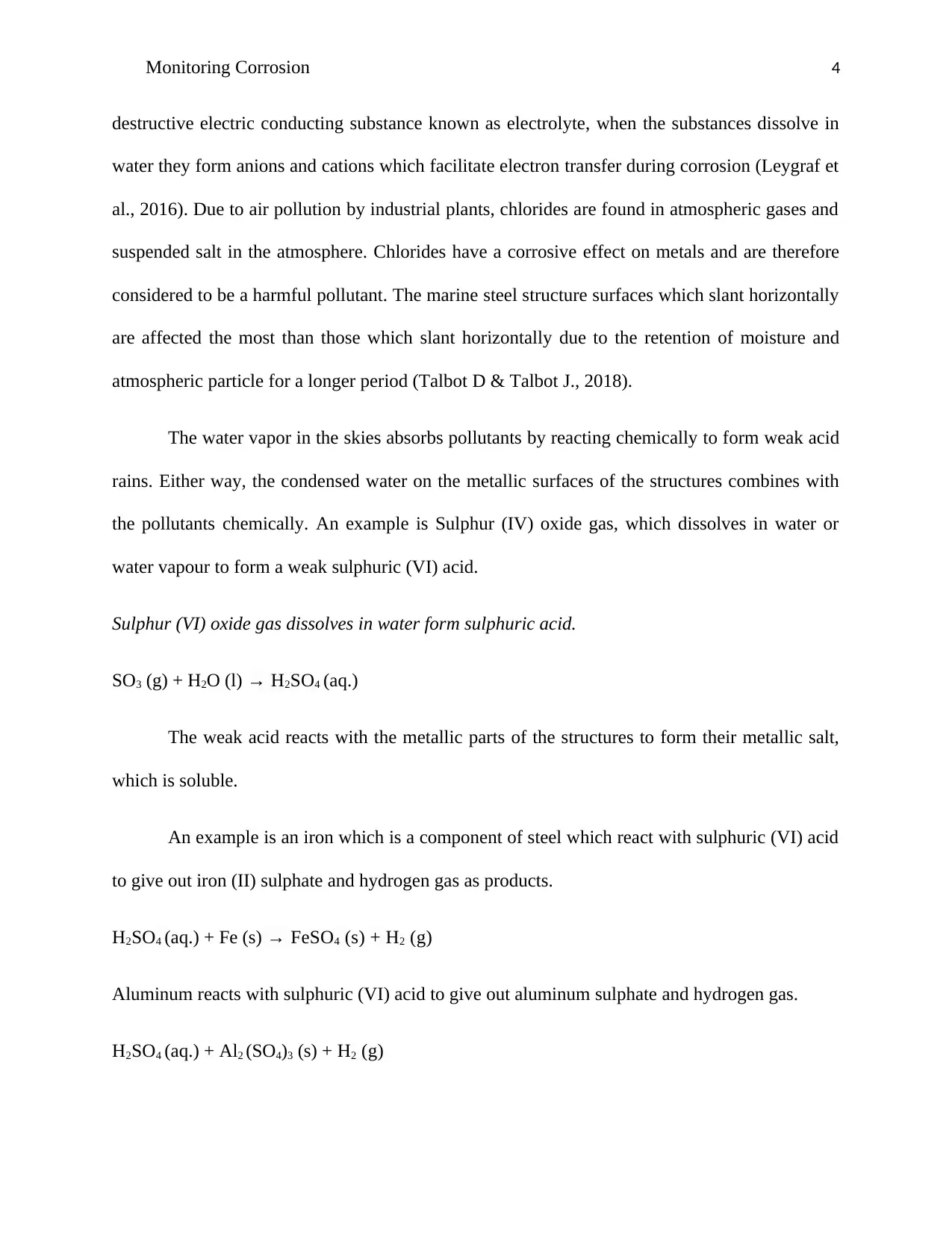
Monitoring Corrosion 4
destructive electric conducting substance known as electrolyte, when the substances dissolve in
water they form anions and cations which facilitate electron transfer during corrosion (Leygraf et
al., 2016). Due to air pollution by industrial plants, chlorides are found in atmospheric gases and
suspended salt in the atmosphere. Chlorides have a corrosive effect on metals and are therefore
considered to be a harmful pollutant. The marine steel structure surfaces which slant horizontally
are affected the most than those which slant horizontally due to the retention of moisture and
atmospheric particle for a longer period (Talbot D & Talbot J., 2018).
The water vapor in the skies absorbs pollutants by reacting chemically to form weak acid
rains. Either way, the condensed water on the metallic surfaces of the structures combines with
the pollutants chemically. An example is Sulphur (IV) oxide gas, which dissolves in water or
water vapour to form a weak sulphuric (VI) acid.
Sulphur (VI) oxide gas dissolves in water form sulphuric acid.
SO3 (g) + H2O (l) → H2SO4 (aq.)
The weak acid reacts with the metallic parts of the structures to form their metallic salt,
which is soluble.
An example is an iron which is a component of steel which react with sulphuric (VI) acid
to give out iron (II) sulphate and hydrogen gas as products.
H2SO4 (aq.) + Fe (s) → FeSO4 (s) + H2 (g)
Aluminum reacts with sulphuric (VI) acid to give out aluminum sulphate and hydrogen gas.
H2SO4 (aq.) + Al2 (SO4)3 (s) + H2 (g)
destructive electric conducting substance known as electrolyte, when the substances dissolve in
water they form anions and cations which facilitate electron transfer during corrosion (Leygraf et
al., 2016). Due to air pollution by industrial plants, chlorides are found in atmospheric gases and
suspended salt in the atmosphere. Chlorides have a corrosive effect on metals and are therefore
considered to be a harmful pollutant. The marine steel structure surfaces which slant horizontally
are affected the most than those which slant horizontally due to the retention of moisture and
atmospheric particle for a longer period (Talbot D & Talbot J., 2018).
The water vapor in the skies absorbs pollutants by reacting chemically to form weak acid
rains. Either way, the condensed water on the metallic surfaces of the structures combines with
the pollutants chemically. An example is Sulphur (IV) oxide gas, which dissolves in water or
water vapour to form a weak sulphuric (VI) acid.
Sulphur (VI) oxide gas dissolves in water form sulphuric acid.
SO3 (g) + H2O (l) → H2SO4 (aq.)
The weak acid reacts with the metallic parts of the structures to form their metallic salt,
which is soluble.
An example is an iron which is a component of steel which react with sulphuric (VI) acid
to give out iron (II) sulphate and hydrogen gas as products.
H2SO4 (aq.) + Fe (s) → FeSO4 (s) + H2 (g)
Aluminum reacts with sulphuric (VI) acid to give out aluminum sulphate and hydrogen gas.
H2SO4 (aq.) + Al2 (SO4)3 (s) + H2 (g)
Paraphrase This Document
Need a fresh take? Get an instant paraphrase of this document with our AI Paraphraser
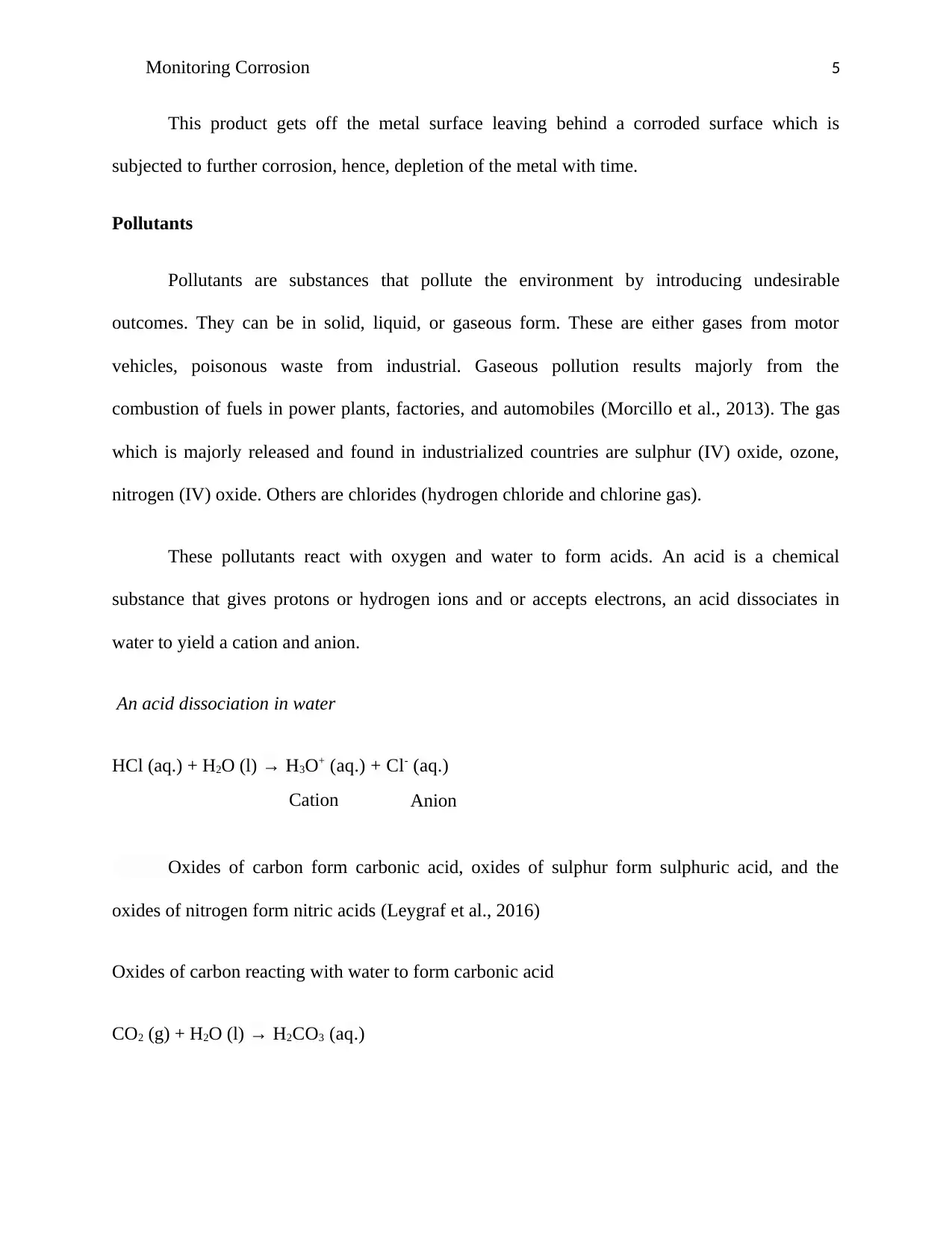
Monitoring Corrosion 5
This product gets off the metal surface leaving behind a corroded surface which is
subjected to further corrosion, hence, depletion of the metal with time.
Pollutants
Pollutants are substances that pollute the environment by introducing undesirable
outcomes. They can be in solid, liquid, or gaseous form. These are either gases from motor
vehicles, poisonous waste from industrial. Gaseous pollution results majorly from the
combustion of fuels in power plants, factories, and automobiles (Morcillo et al., 2013). The gas
which is majorly released and found in industrialized countries are sulphur (IV) oxide, ozone,
nitrogen (IV) oxide. Others are chlorides (hydrogen chloride and chlorine gas).
These pollutants react with oxygen and water to form acids. An acid is a chemical
substance that gives protons or hydrogen ions and or accepts electrons, an acid dissociates in
water to yield a cation and anion.
An acid dissociation in water
HCl (aq.) + H2O (l) → H3O+ (aq.) + Cl- (aq.)
Oxides of carbon form carbonic acid, oxides of sulphur form sulphuric acid, and the
oxides of nitrogen form nitric acids (Leygraf et al., 2016)
Oxides of carbon reacting with water to form carbonic acid
CO2 (g) + H2O (l) → H2CO3 (aq.)
Cation Anion
This product gets off the metal surface leaving behind a corroded surface which is
subjected to further corrosion, hence, depletion of the metal with time.
Pollutants
Pollutants are substances that pollute the environment by introducing undesirable
outcomes. They can be in solid, liquid, or gaseous form. These are either gases from motor
vehicles, poisonous waste from industrial. Gaseous pollution results majorly from the
combustion of fuels in power plants, factories, and automobiles (Morcillo et al., 2013). The gas
which is majorly released and found in industrialized countries are sulphur (IV) oxide, ozone,
nitrogen (IV) oxide. Others are chlorides (hydrogen chloride and chlorine gas).
These pollutants react with oxygen and water to form acids. An acid is a chemical
substance that gives protons or hydrogen ions and or accepts electrons, an acid dissociates in
water to yield a cation and anion.
An acid dissociation in water
HCl (aq.) + H2O (l) → H3O+ (aq.) + Cl- (aq.)
Oxides of carbon form carbonic acid, oxides of sulphur form sulphuric acid, and the
oxides of nitrogen form nitric acids (Leygraf et al., 2016)
Oxides of carbon reacting with water to form carbonic acid
CO2 (g) + H2O (l) → H2CO3 (aq.)
Cation Anion
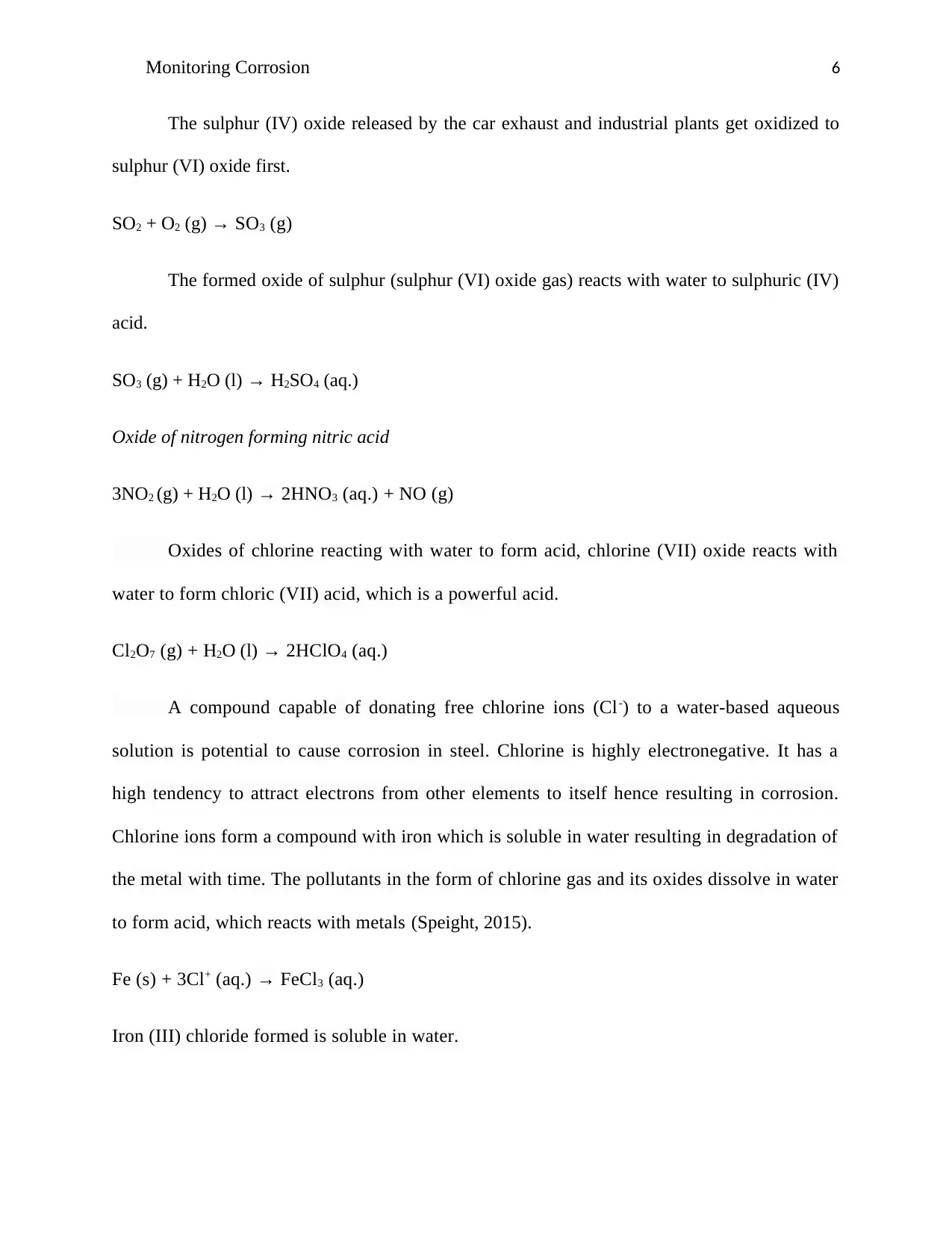
Monitoring Corrosion 6
The sulphur (IV) oxide released by the car exhaust and industrial plants get oxidized to
sulphur (VI) oxide first.
SO2 + O2 (g) → SO3 (g)
The formed oxide of sulphur (sulphur (VI) oxide gas) reacts with water to sulphuric (IV)
acid.
SO3 (g) + H2O (l) → H2SO4 (aq.)
Oxide of nitrogen forming nitric acid
3NO2 (g) + H2O (l) → 2HNO3 (aq.) + NO (g)
Oxides of chlorine reacting with water to form acid, chlorine (VII) oxide reacts with
water to form chloric (VII) acid, which is a powerful acid.
Cl2O7 (g) + H2O (l) → 2HClO4 (aq.)
A compound capable of donating free chlorine ions (Cl-) to a water-based aqueous
solution is potential to cause corrosion in steel. Chlorine is highly electronegative. It has a
high tendency to attract electrons from other elements to itself hence resulting in corrosion.
Chlorine ions form a compound with iron which is soluble in water resulting in degradation of
the metal with time. The pollutants in the form of chlorine gas and its oxides dissolve in water
to form acid, which reacts with metals (Speight, 2015).
Fe (s) + 3Cl+ (aq.) → FeCl3 (aq.)
Iron (III) chloride formed is soluble in water.
The sulphur (IV) oxide released by the car exhaust and industrial plants get oxidized to
sulphur (VI) oxide first.
SO2 + O2 (g) → SO3 (g)
The formed oxide of sulphur (sulphur (VI) oxide gas) reacts with water to sulphuric (IV)
acid.
SO3 (g) + H2O (l) → H2SO4 (aq.)
Oxide of nitrogen forming nitric acid
3NO2 (g) + H2O (l) → 2HNO3 (aq.) + NO (g)
Oxides of chlorine reacting with water to form acid, chlorine (VII) oxide reacts with
water to form chloric (VII) acid, which is a powerful acid.
Cl2O7 (g) + H2O (l) → 2HClO4 (aq.)
A compound capable of donating free chlorine ions (Cl-) to a water-based aqueous
solution is potential to cause corrosion in steel. Chlorine is highly electronegative. It has a
high tendency to attract electrons from other elements to itself hence resulting in corrosion.
Chlorine ions form a compound with iron which is soluble in water resulting in degradation of
the metal with time. The pollutants in the form of chlorine gas and its oxides dissolve in water
to form acid, which reacts with metals (Speight, 2015).
Fe (s) + 3Cl+ (aq.) → FeCl3 (aq.)
Iron (III) chloride formed is soluble in water.
⊘ This is a preview!⊘
Do you want full access?
Subscribe today to unlock all pages.

Trusted by 1+ million students worldwide
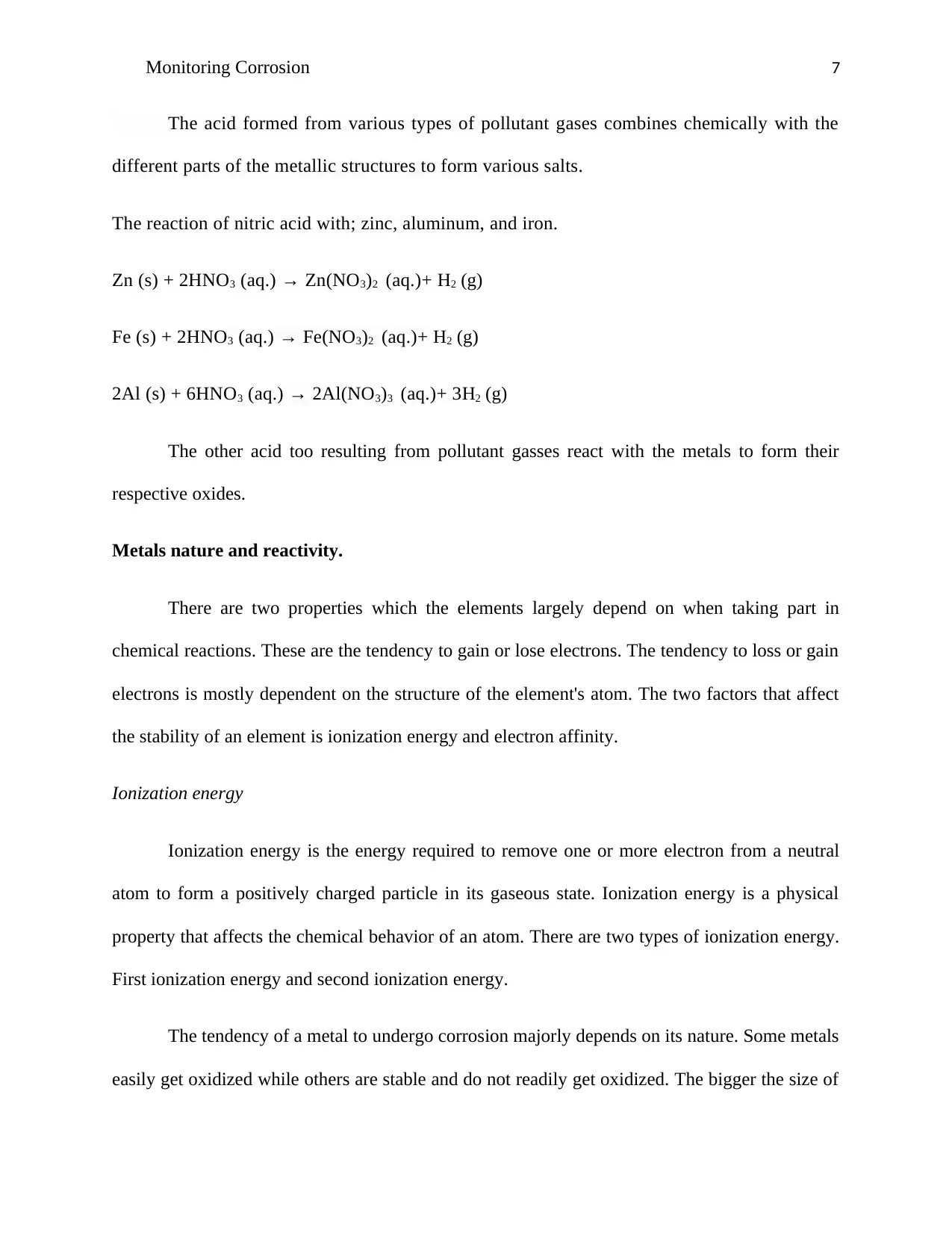
Monitoring Corrosion 7
The acid formed from various types of pollutant gases combines chemically with the
different parts of the metallic structures to form various salts.
The reaction of nitric acid with; zinc, aluminum, and iron.
Zn (s) + 2HNO3 (aq.) → Zn(NO3)2 (aq.)+ H2 (g)
Fe (s) + 2HNO3 (aq.) → Fe(NO3)2 (aq.)+ H2 (g)
2Al (s) + 6HNO3 (aq.) → 2Al(NO3)3 (aq.)+ 3H2 (g)
The other acid too resulting from pollutant gasses react with the metals to form their
respective oxides.
Metals nature and reactivity.
There are two properties which the elements largely depend on when taking part in
chemical reactions. These are the tendency to gain or lose electrons. The tendency to loss or gain
electrons is mostly dependent on the structure of the element's atom. The two factors that affect
the stability of an element is ionization energy and electron affinity.
Ionization energy
Ionization energy is the energy required to remove one or more electron from a neutral
atom to form a positively charged particle in its gaseous state. Ionization energy is a physical
property that affects the chemical behavior of an atom. There are two types of ionization energy.
First ionization energy and second ionization energy.
The tendency of a metal to undergo corrosion majorly depends on its nature. Some metals
easily get oxidized while others are stable and do not readily get oxidized. The bigger the size of
The acid formed from various types of pollutant gases combines chemically with the
different parts of the metallic structures to form various salts.
The reaction of nitric acid with; zinc, aluminum, and iron.
Zn (s) + 2HNO3 (aq.) → Zn(NO3)2 (aq.)+ H2 (g)
Fe (s) + 2HNO3 (aq.) → Fe(NO3)2 (aq.)+ H2 (g)
2Al (s) + 6HNO3 (aq.) → 2Al(NO3)3 (aq.)+ 3H2 (g)
The other acid too resulting from pollutant gasses react with the metals to form their
respective oxides.
Metals nature and reactivity.
There are two properties which the elements largely depend on when taking part in
chemical reactions. These are the tendency to gain or lose electrons. The tendency to loss or gain
electrons is mostly dependent on the structure of the element's atom. The two factors that affect
the stability of an element is ionization energy and electron affinity.
Ionization energy
Ionization energy is the energy required to remove one or more electron from a neutral
atom to form a positively charged particle in its gaseous state. Ionization energy is a physical
property that affects the chemical behavior of an atom. There are two types of ionization energy.
First ionization energy and second ionization energy.
The tendency of a metal to undergo corrosion majorly depends on its nature. Some metals
easily get oxidized while others are stable and do not readily get oxidized. The bigger the size of
Paraphrase This Document
Need a fresh take? Get an instant paraphrase of this document with our AI Paraphraser
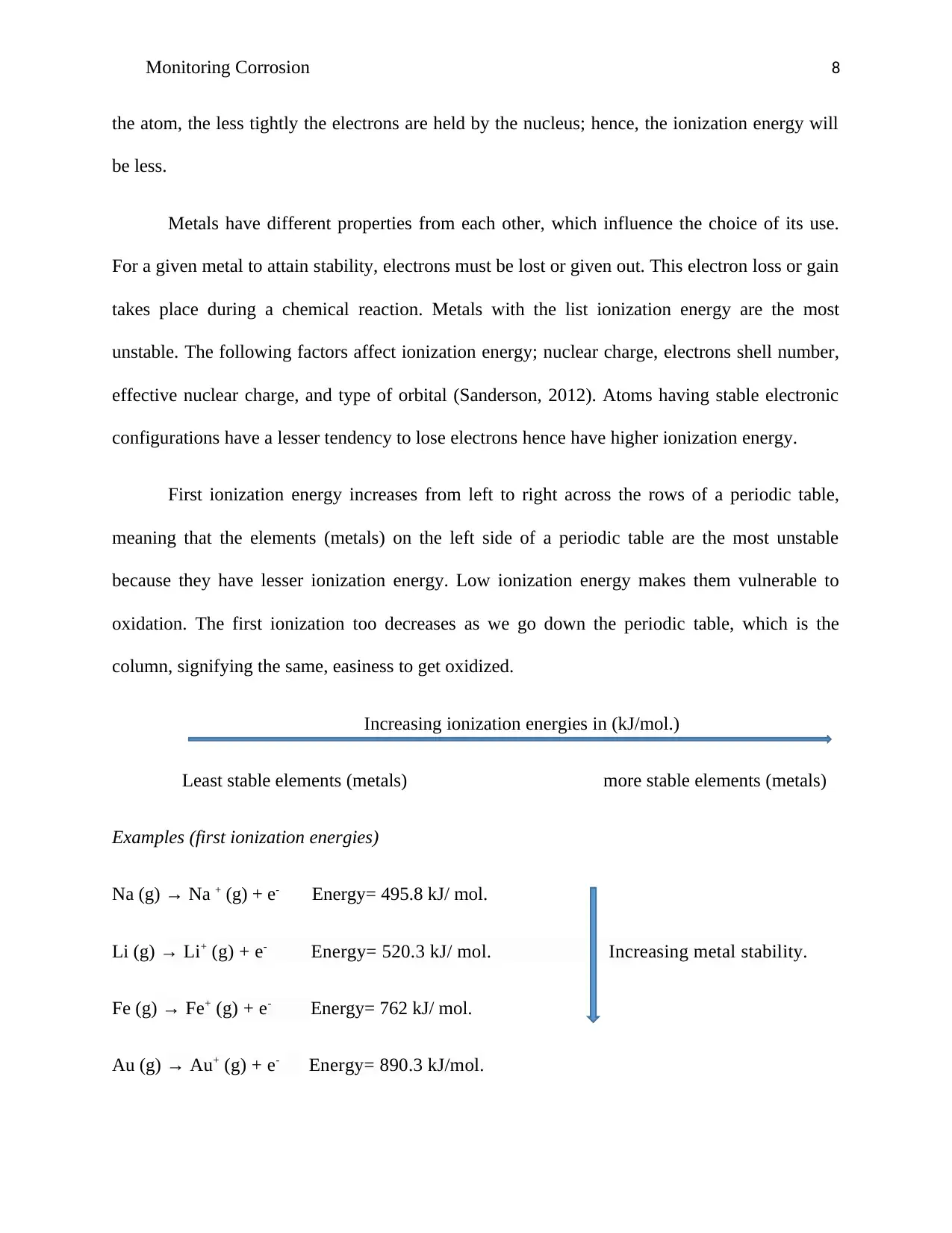
Monitoring Corrosion 8
the atom, the less tightly the electrons are held by the nucleus; hence, the ionization energy will
be less.
Metals have different properties from each other, which influence the choice of its use.
For a given metal to attain stability, electrons must be lost or given out. This electron loss or gain
takes place during a chemical reaction. Metals with the list ionization energy are the most
unstable. The following factors affect ionization energy; nuclear charge, electrons shell number,
effective nuclear charge, and type of orbital (Sanderson, 2012). Atoms having stable electronic
configurations have a lesser tendency to lose electrons hence have higher ionization energy.
First ionization energy increases from left to right across the rows of a periodic table,
meaning that the elements (metals) on the left side of a periodic table are the most unstable
because they have lesser ionization energy. Low ionization energy makes them vulnerable to
oxidation. The first ionization too decreases as we go down the periodic table, which is the
column, signifying the same, easiness to get oxidized.
Increasing ionization energies in (kJ/mol.)
Least stable elements (metals) more stable elements (metals)
Examples (first ionization energies)
Na (g) → Na + (g) + e- Energy= 495.8 kJ/ mol.
Li (g) → Li+ (g) + e- Energy= 520.3 kJ/ mol. Increasing metal stability.
Fe (g) → Fe+ (g) + e- Energy= 762 kJ/ mol.
Au (g) → Au+ (g) + e- Energy= 890.3 kJ/mol.
the atom, the less tightly the electrons are held by the nucleus; hence, the ionization energy will
be less.
Metals have different properties from each other, which influence the choice of its use.
For a given metal to attain stability, electrons must be lost or given out. This electron loss or gain
takes place during a chemical reaction. Metals with the list ionization energy are the most
unstable. The following factors affect ionization energy; nuclear charge, electrons shell number,
effective nuclear charge, and type of orbital (Sanderson, 2012). Atoms having stable electronic
configurations have a lesser tendency to lose electrons hence have higher ionization energy.
First ionization energy increases from left to right across the rows of a periodic table,
meaning that the elements (metals) on the left side of a periodic table are the most unstable
because they have lesser ionization energy. Low ionization energy makes them vulnerable to
oxidation. The first ionization too decreases as we go down the periodic table, which is the
column, signifying the same, easiness to get oxidized.
Increasing ionization energies in (kJ/mol.)
Least stable elements (metals) more stable elements (metals)
Examples (first ionization energies)
Na (g) → Na + (g) + e- Energy= 495.8 kJ/ mol.
Li (g) → Li+ (g) + e- Energy= 520.3 kJ/ mol. Increasing metal stability.
Fe (g) → Fe+ (g) + e- Energy= 762 kJ/ mol.
Au (g) → Au+ (g) + e- Energy= 890.3 kJ/mol.
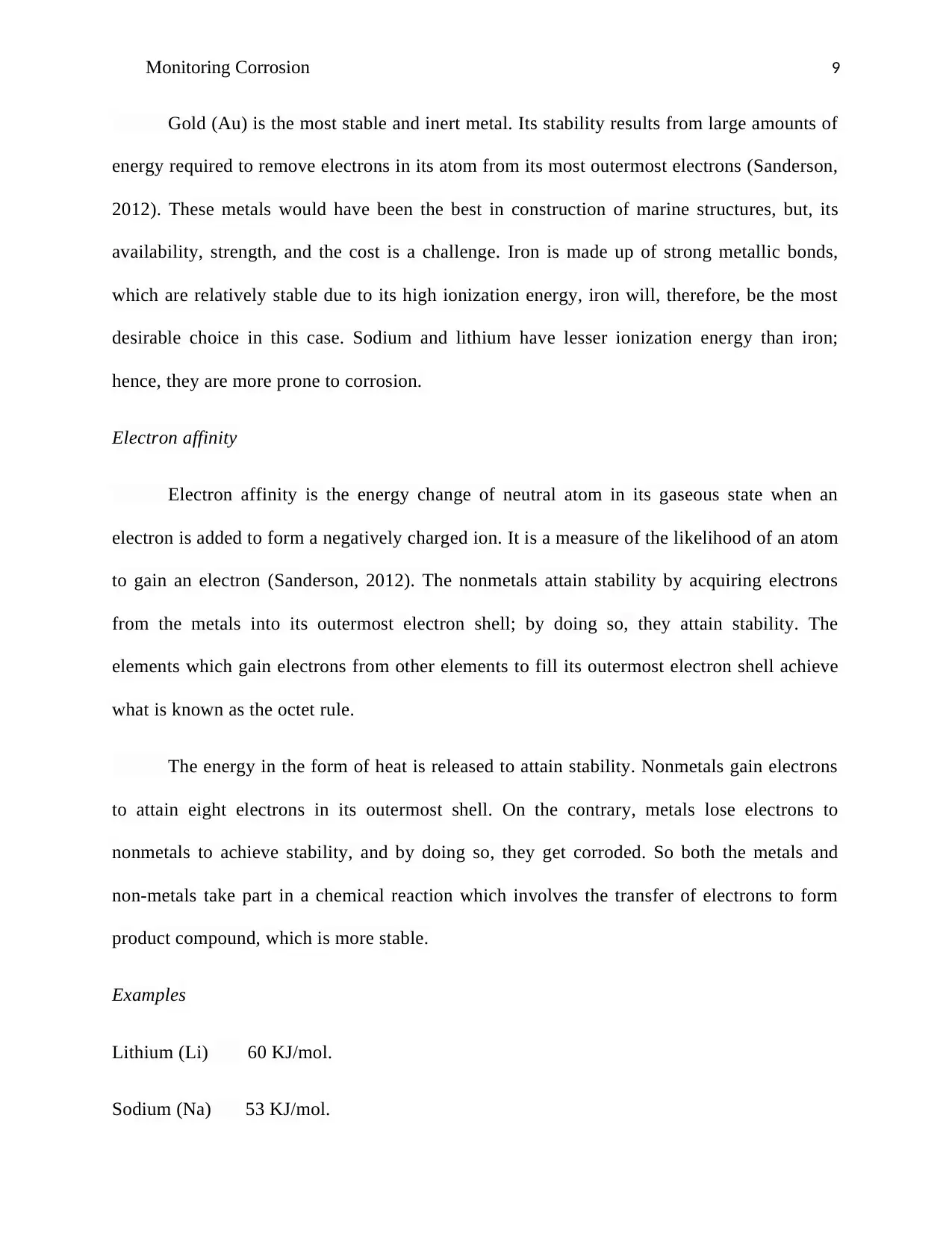
Monitoring Corrosion 9
Gold (Au) is the most stable and inert metal. Its stability results from large amounts of
energy required to remove electrons in its atom from its most outermost electrons (Sanderson,
2012). These metals would have been the best in construction of marine structures, but, its
availability, strength, and the cost is a challenge. Iron is made up of strong metallic bonds,
which are relatively stable due to its high ionization energy, iron will, therefore, be the most
desirable choice in this case. Sodium and lithium have lesser ionization energy than iron;
hence, they are more prone to corrosion.
Electron affinity
Electron affinity is the energy change of neutral atom in its gaseous state when an
electron is added to form a negatively charged ion. It is a measure of the likelihood of an atom
to gain an electron (Sanderson, 2012). The nonmetals attain stability by acquiring electrons
from the metals into its outermost electron shell; by doing so, they attain stability. The
elements which gain electrons from other elements to fill its outermost electron shell achieve
what is known as the octet rule.
The energy in the form of heat is released to attain stability. Nonmetals gain electrons
to attain eight electrons in its outermost shell. On the contrary, metals lose electrons to
nonmetals to achieve stability, and by doing so, they get corroded. So both the metals and
non-metals take part in a chemical reaction which involves the transfer of electrons to form
product compound, which is more stable.
Examples
Lithium (Li) 60 KJ/mol.
Sodium (Na) 53 KJ/mol.
Gold (Au) is the most stable and inert metal. Its stability results from large amounts of
energy required to remove electrons in its atom from its most outermost electrons (Sanderson,
2012). These metals would have been the best in construction of marine structures, but, its
availability, strength, and the cost is a challenge. Iron is made up of strong metallic bonds,
which are relatively stable due to its high ionization energy, iron will, therefore, be the most
desirable choice in this case. Sodium and lithium have lesser ionization energy than iron;
hence, they are more prone to corrosion.
Electron affinity
Electron affinity is the energy change of neutral atom in its gaseous state when an
electron is added to form a negatively charged ion. It is a measure of the likelihood of an atom
to gain an electron (Sanderson, 2012). The nonmetals attain stability by acquiring electrons
from the metals into its outermost electron shell; by doing so, they attain stability. The
elements which gain electrons from other elements to fill its outermost electron shell achieve
what is known as the octet rule.
The energy in the form of heat is released to attain stability. Nonmetals gain electrons
to attain eight electrons in its outermost shell. On the contrary, metals lose electrons to
nonmetals to achieve stability, and by doing so, they get corroded. So both the metals and
non-metals take part in a chemical reaction which involves the transfer of electrons to form
product compound, which is more stable.
Examples
Lithium (Li) 60 KJ/mol.
Sodium (Na) 53 KJ/mol.
⊘ This is a preview!⊘
Do you want full access?
Subscribe today to unlock all pages.

Trusted by 1+ million students worldwide
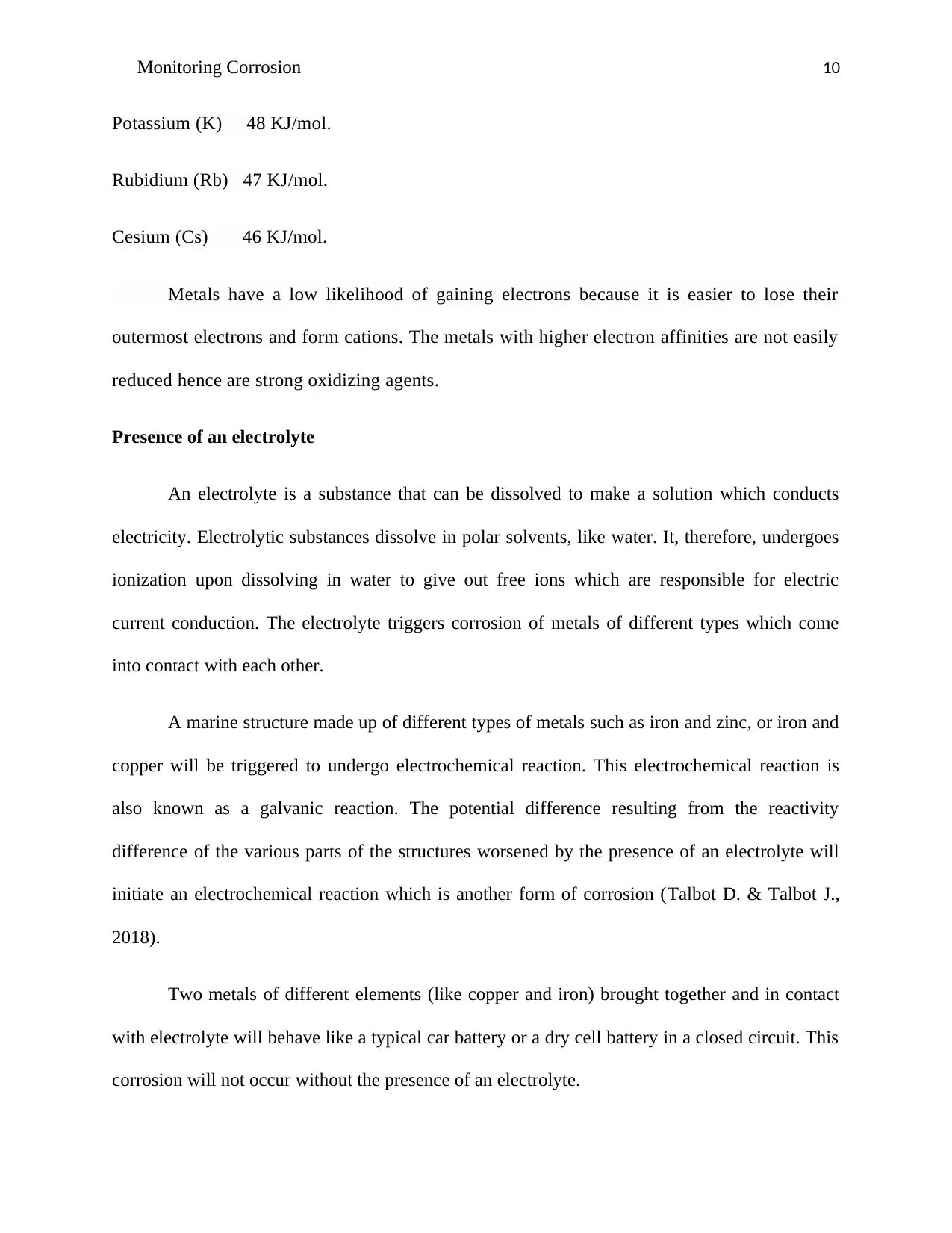
Monitoring Corrosion 10
Potassium (K) 48 KJ/mol.
Rubidium (Rb) 47 KJ/mol.
Cesium (Cs) 46 KJ/mol.
Metals have a low likelihood of gaining electrons because it is easier to lose their
outermost electrons and form cations. The metals with higher electron affinities are not easily
reduced hence are strong oxidizing agents.
Presence of an electrolyte
An electrolyte is a substance that can be dissolved to make a solution which conducts
electricity. Electrolytic substances dissolve in polar solvents, like water. It, therefore, undergoes
ionization upon dissolving in water to give out free ions which are responsible for electric
current conduction. The electrolyte triggers corrosion of metals of different types which come
into contact with each other.
A marine structure made up of different types of metals such as iron and zinc, or iron and
copper will be triggered to undergo electrochemical reaction. This electrochemical reaction is
also known as a galvanic reaction. The potential difference resulting from the reactivity
difference of the various parts of the structures worsened by the presence of an electrolyte will
initiate an electrochemical reaction which is another form of corrosion (Talbot D. & Talbot J.,
2018).
Two metals of different elements (like copper and iron) brought together and in contact
with electrolyte will behave like a typical car battery or a dry cell battery in a closed circuit. This
corrosion will not occur without the presence of an electrolyte.
Potassium (K) 48 KJ/mol.
Rubidium (Rb) 47 KJ/mol.
Cesium (Cs) 46 KJ/mol.
Metals have a low likelihood of gaining electrons because it is easier to lose their
outermost electrons and form cations. The metals with higher electron affinities are not easily
reduced hence are strong oxidizing agents.
Presence of an electrolyte
An electrolyte is a substance that can be dissolved to make a solution which conducts
electricity. Electrolytic substances dissolve in polar solvents, like water. It, therefore, undergoes
ionization upon dissolving in water to give out free ions which are responsible for electric
current conduction. The electrolyte triggers corrosion of metals of different types which come
into contact with each other.
A marine structure made up of different types of metals such as iron and zinc, or iron and
copper will be triggered to undergo electrochemical reaction. This electrochemical reaction is
also known as a galvanic reaction. The potential difference resulting from the reactivity
difference of the various parts of the structures worsened by the presence of an electrolyte will
initiate an electrochemical reaction which is another form of corrosion (Talbot D. & Talbot J.,
2018).
Two metals of different elements (like copper and iron) brought together and in contact
with electrolyte will behave like a typical car battery or a dry cell battery in a closed circuit. This
corrosion will not occur without the presence of an electrolyte.
Paraphrase This Document
Need a fresh take? Get an instant paraphrase of this document with our AI Paraphraser
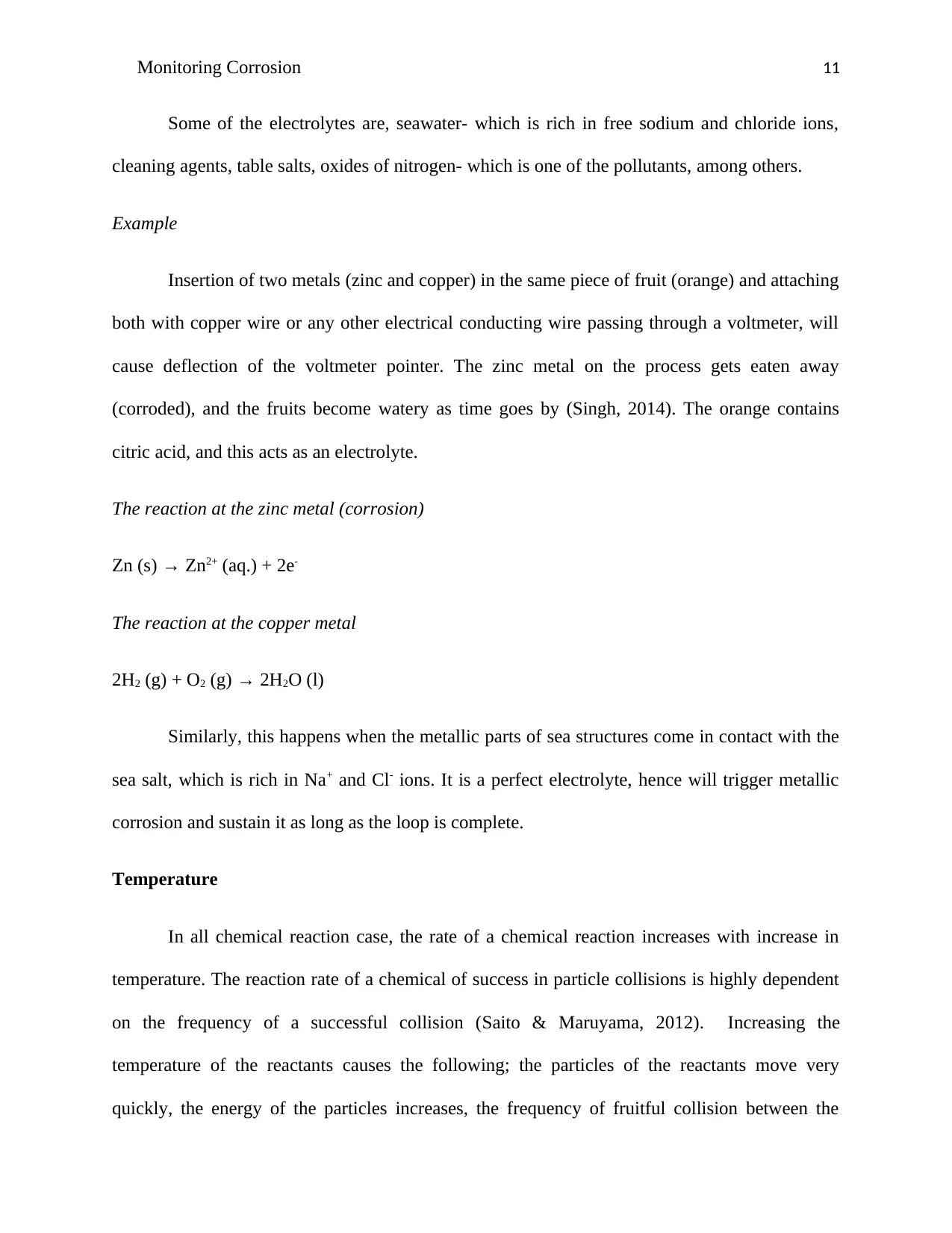
Monitoring Corrosion 11
Some of the electrolytes are, seawater- which is rich in free sodium and chloride ions,
cleaning agents, table salts, oxides of nitrogen- which is one of the pollutants, among others.
Example
Insertion of two metals (zinc and copper) in the same piece of fruit (orange) and attaching
both with copper wire or any other electrical conducting wire passing through a voltmeter, will
cause deflection of the voltmeter pointer. The zinc metal on the process gets eaten away
(corroded), and the fruits become watery as time goes by (Singh, 2014). The orange contains
citric acid, and this acts as an electrolyte.
The reaction at the zinc metal (corrosion)
Zn (s) → Zn2+ (aq.) + 2e-
The reaction at the copper metal
2H2 (g) + O2 (g) → 2H2O (l)
Similarly, this happens when the metallic parts of sea structures come in contact with the
sea salt, which is rich in Na+ and Cl- ions. It is a perfect electrolyte, hence will trigger metallic
corrosion and sustain it as long as the loop is complete.
Temperature
In all chemical reaction case, the rate of a chemical reaction increases with increase in
temperature. The reaction rate of a chemical of success in particle collisions is highly dependent
on the frequency of a successful collision (Saito & Maruyama, 2012). Increasing the
temperature of the reactants causes the following; the particles of the reactants move very
quickly, the energy of the particles increases, the frequency of fruitful collision between the
Some of the electrolytes are, seawater- which is rich in free sodium and chloride ions,
cleaning agents, table salts, oxides of nitrogen- which is one of the pollutants, among others.
Example
Insertion of two metals (zinc and copper) in the same piece of fruit (orange) and attaching
both with copper wire or any other electrical conducting wire passing through a voltmeter, will
cause deflection of the voltmeter pointer. The zinc metal on the process gets eaten away
(corroded), and the fruits become watery as time goes by (Singh, 2014). The orange contains
citric acid, and this acts as an electrolyte.
The reaction at the zinc metal (corrosion)
Zn (s) → Zn2+ (aq.) + 2e-
The reaction at the copper metal
2H2 (g) + O2 (g) → 2H2O (l)
Similarly, this happens when the metallic parts of sea structures come in contact with the
sea salt, which is rich in Na+ and Cl- ions. It is a perfect electrolyte, hence will trigger metallic
corrosion and sustain it as long as the loop is complete.
Temperature
In all chemical reaction case, the rate of a chemical reaction increases with increase in
temperature. The reaction rate of a chemical of success in particle collisions is highly dependent
on the frequency of a successful collision (Saito & Maruyama, 2012). Increasing the
temperature of the reactants causes the following; the particles of the reactants move very
quickly, the energy of the particles increases, the frequency of fruitful collision between the
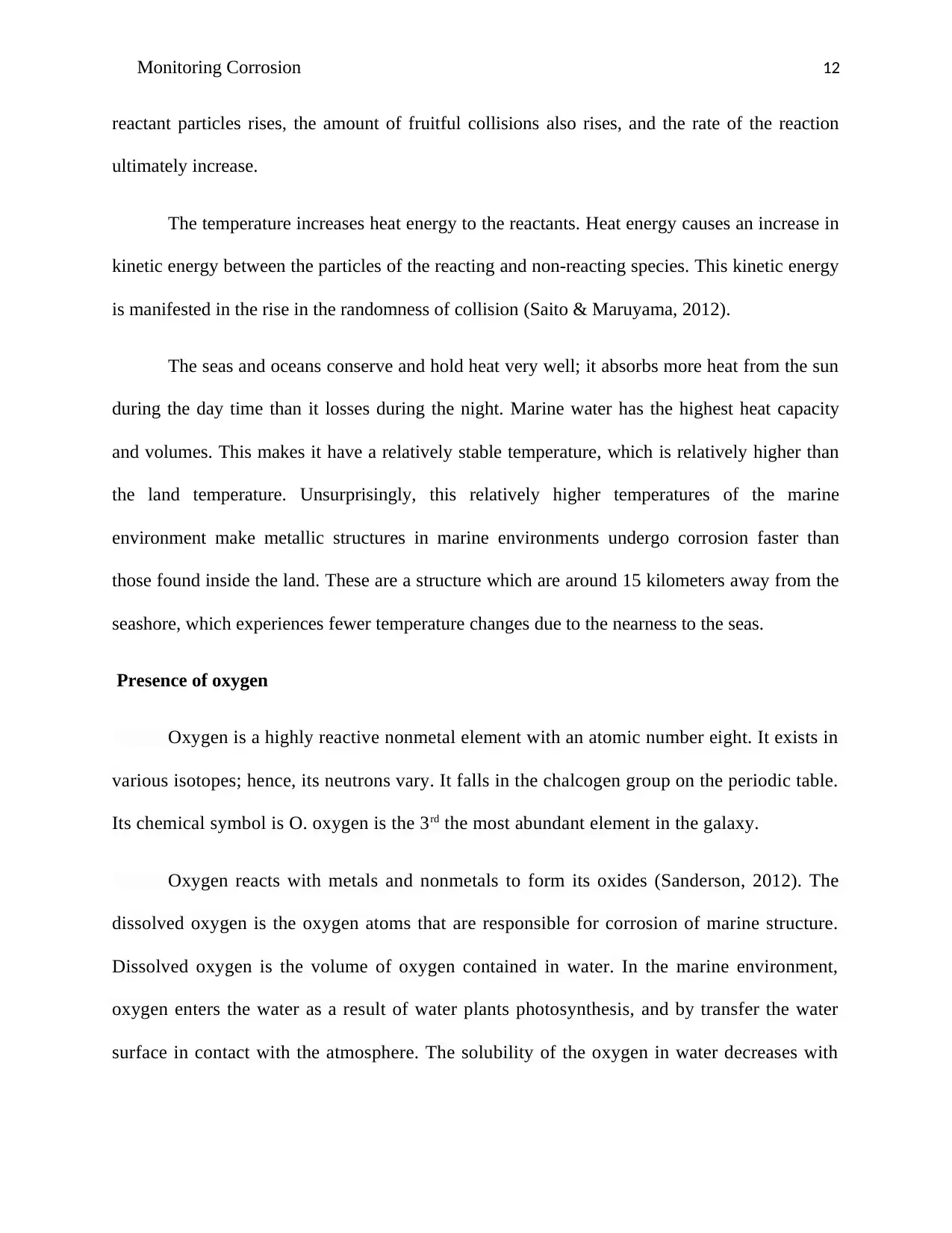
Monitoring Corrosion 12
reactant particles rises, the amount of fruitful collisions also rises, and the rate of the reaction
ultimately increase.
The temperature increases heat energy to the reactants. Heat energy causes an increase in
kinetic energy between the particles of the reacting and non-reacting species. This kinetic energy
is manifested in the rise in the randomness of collision (Saito & Maruyama, 2012).
The seas and oceans conserve and hold heat very well; it absorbs more heat from the sun
during the day time than it losses during the night. Marine water has the highest heat capacity
and volumes. This makes it have a relatively stable temperature, which is relatively higher than
the land temperature. Unsurprisingly, this relatively higher temperatures of the marine
environment make metallic structures in marine environments undergo corrosion faster than
those found inside the land. These are a structure which are around 15 kilometers away from the
seashore, which experiences fewer temperature changes due to the nearness to the seas.
Presence of oxygen
Oxygen is a highly reactive nonmetal element with an atomic number eight. It exists in
various isotopes; hence, its neutrons vary. It falls in the chalcogen group on the periodic table.
Its chemical symbol is O. oxygen is the 3rd the most abundant element in the galaxy.
Oxygen reacts with metals and nonmetals to form its oxides (Sanderson, 2012). The
dissolved oxygen is the oxygen atoms that are responsible for corrosion of marine structure.
Dissolved oxygen is the volume of oxygen contained in water. In the marine environment,
oxygen enters the water as a result of water plants photosynthesis, and by transfer the water
surface in contact with the atmosphere. The solubility of the oxygen in water decreases with
reactant particles rises, the amount of fruitful collisions also rises, and the rate of the reaction
ultimately increase.
The temperature increases heat energy to the reactants. Heat energy causes an increase in
kinetic energy between the particles of the reacting and non-reacting species. This kinetic energy
is manifested in the rise in the randomness of collision (Saito & Maruyama, 2012).
The seas and oceans conserve and hold heat very well; it absorbs more heat from the sun
during the day time than it losses during the night. Marine water has the highest heat capacity
and volumes. This makes it have a relatively stable temperature, which is relatively higher than
the land temperature. Unsurprisingly, this relatively higher temperatures of the marine
environment make metallic structures in marine environments undergo corrosion faster than
those found inside the land. These are a structure which are around 15 kilometers away from the
seashore, which experiences fewer temperature changes due to the nearness to the seas.
Presence of oxygen
Oxygen is a highly reactive nonmetal element with an atomic number eight. It exists in
various isotopes; hence, its neutrons vary. It falls in the chalcogen group on the periodic table.
Its chemical symbol is O. oxygen is the 3rd the most abundant element in the galaxy.
Oxygen reacts with metals and nonmetals to form its oxides (Sanderson, 2012). The
dissolved oxygen is the oxygen atoms that are responsible for corrosion of marine structure.
Dissolved oxygen is the volume of oxygen contained in water. In the marine environment,
oxygen enters the water as a result of water plants photosynthesis, and by transfer the water
surface in contact with the atmosphere. The solubility of the oxygen in water decreases with
⊘ This is a preview!⊘
Do you want full access?
Subscribe today to unlock all pages.

Trusted by 1+ million students worldwide
1 out of 33
Your All-in-One AI-Powered Toolkit for Academic Success.
+13062052269
info@desklib.com
Available 24*7 on WhatsApp / Email
![[object Object]](/_next/static/media/star-bottom.7253800d.svg)
Unlock your academic potential
Copyright © 2020–2025 A2Z Services. All Rights Reserved. Developed and managed by ZUCOL.

